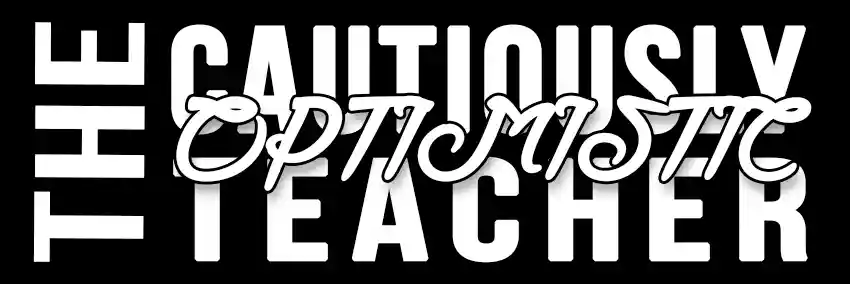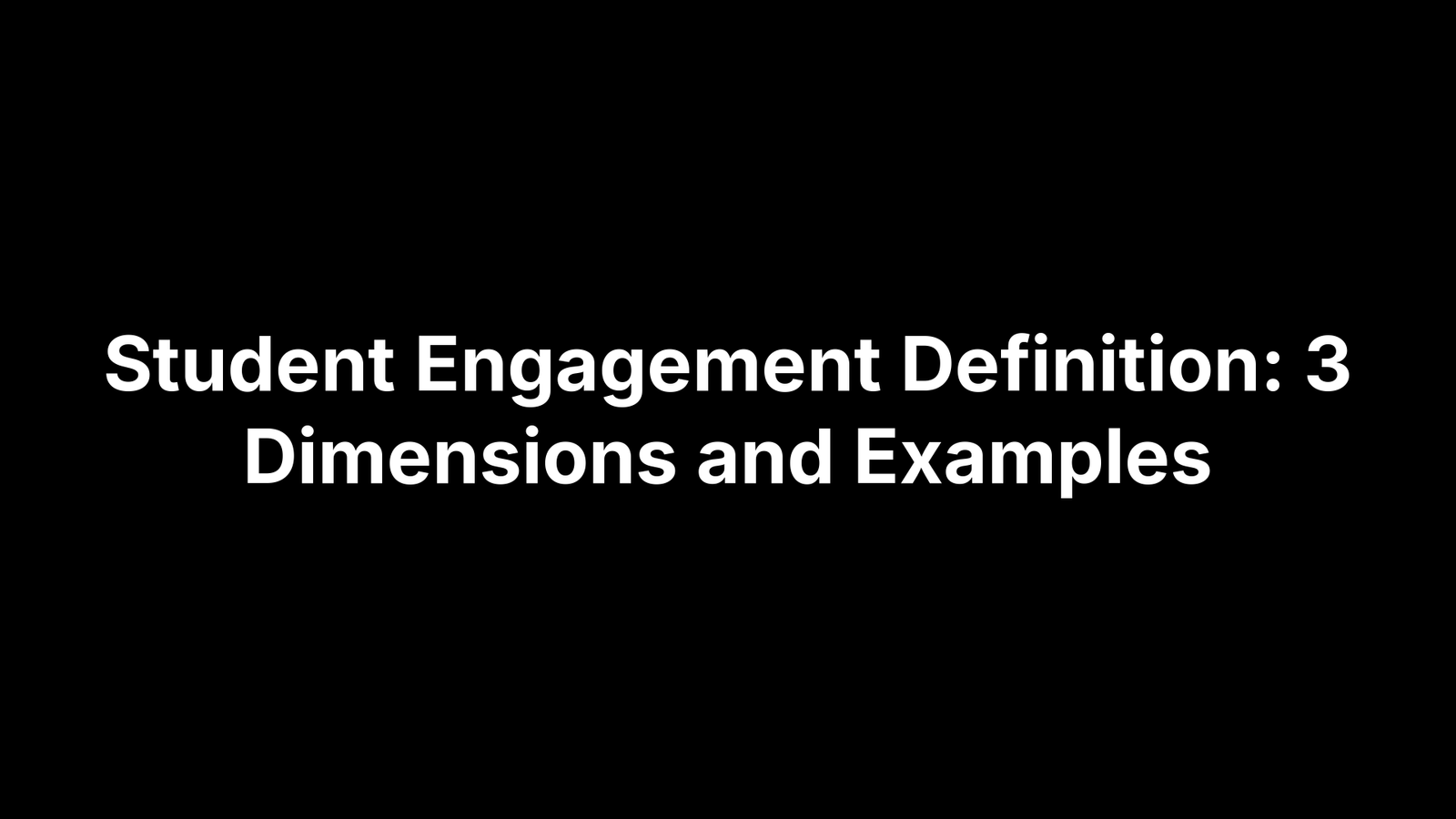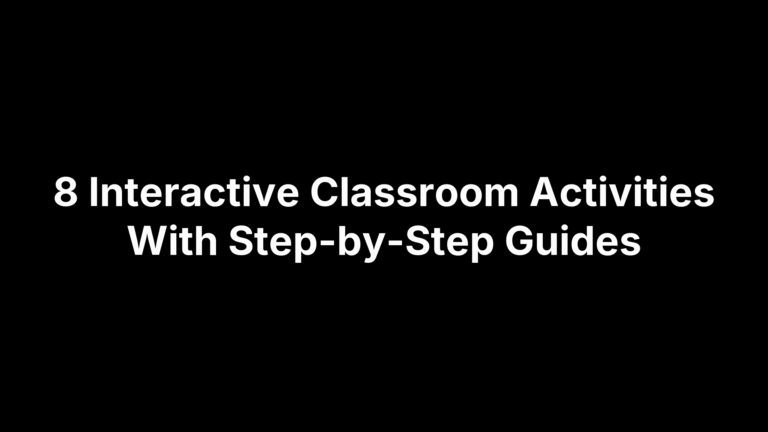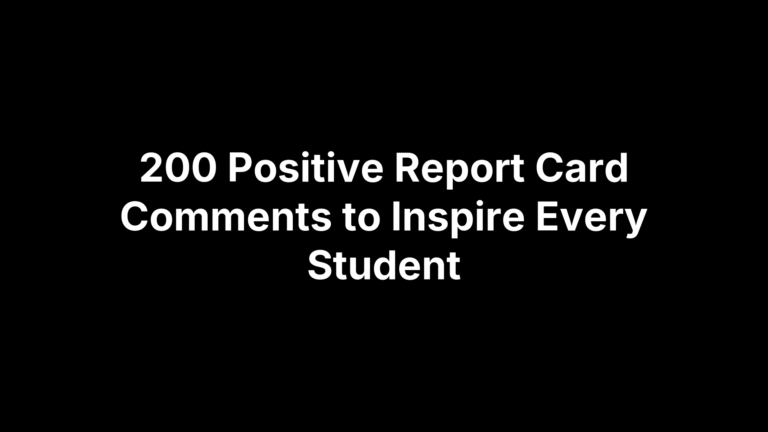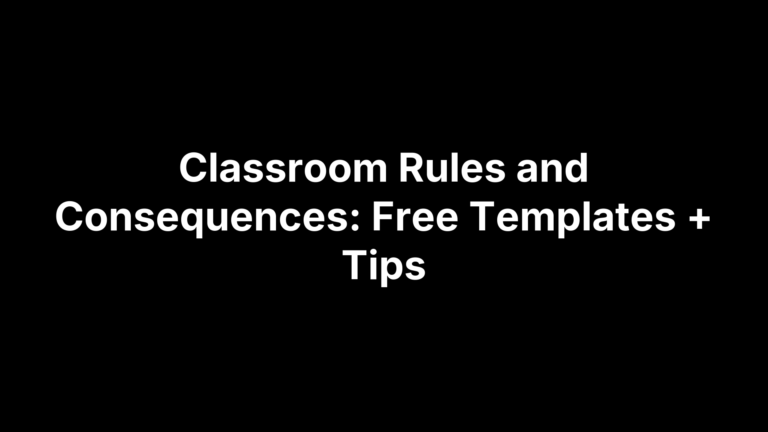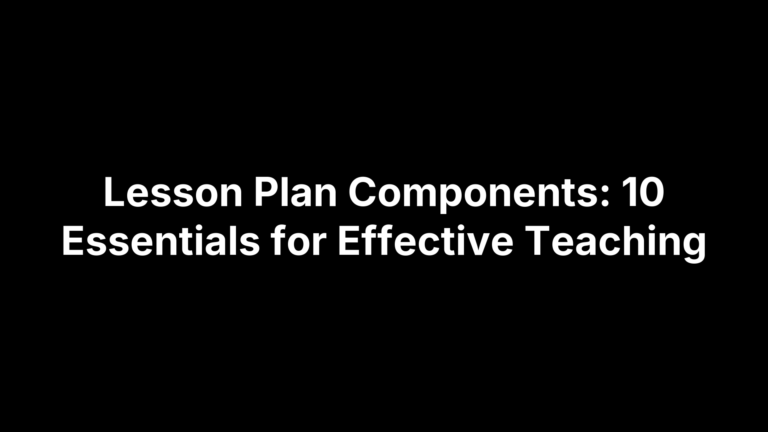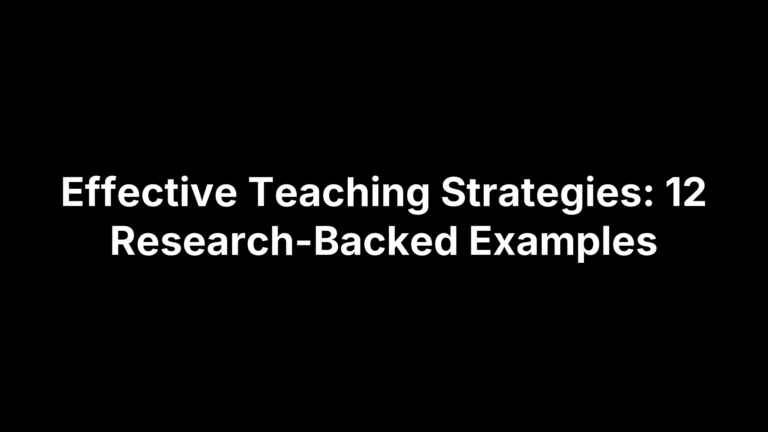Student Engagement Definition: 3 Dimensions and Examples
Student engagement is the degree to which students are attentive, curious, and genuinely invested in their learning. It shows up in three connected ways: what students do (behavioral—showing up, participating, completing work), how they think (cognitive—using strategies, persisting through challenge, making meaning), and how they feel (emotional—belonging, interest, optimism). Real engagement isn’t just quiet compliance or flashy activities; it’s purposeful participation that moves learning forward and helps students see the relevance of school to their lives.
This article gives you a clear, working definition of student engagement and unpacks each dimension with practical classroom examples. You’ll see how the three pieces reinforce one another, how to check engagement in the moment and track it over time, and research-aligned strategies you can try this week. We’ll also cover designing for engagement with UDL, student choice, and relevance; using technology and AI to personalize support; ensuring equity and cultural responsiveness; quick five-minute spark activities; and common pitfalls to avoid. First, let’s ground the term so we’re speaking the same language.
Why engagement matters in K–12 classrooms
When students lean in—curious, focused, and emotionally invested—learning accelerates. Decades of classroom practice and summaries of research connect “non‑cognitive” factors like motivation, interest, perseverance, and self‑regulation to “cognitive” results such as higher academic performance, improved recall, and stronger skill acquisition. Student engagement is also multi‑faceted: what students do, how they think, and how they feel each shape day‑to‑day participation, longer‑term growth, and whether students stick with challenging work. In K–12 settings, that translates into better classroom climate, fewer off‑task behaviors, and a stronger sense of belonging that supports attendance and persistence.
- Stronger learning: More meaningful practice, deeper understanding, and better transfer of skills.
- Healthier climate: Positive emotions and relationships that reduce disruptions and build trust.
- Greater persistence: Willingness to tackle challenges and finish what they start.
- Equity gains: Inclusive engagement practices help more students access and show what they know.
Next, we’ll start with the most visible piece: behavioral engagement.
Behavioral engagement: observable actions and classroom examples
Behavioral engagement is what you can see: students attend, come prepared, follow routines, participate appropriately, stay on task, and turn work in on time. It improves when classrooms run on predictable routines, teachers use consistent cues to regain attention, and lessons include varied formats that reduce monotony. Short physical or social shifts, along with rotating student roles, help refocus energy and sustain momentum. In the student engagement definition, this dimension is about action—yet it lays the groundwork for deeper thinking and positive emotions.
- Use clear attention signals: Clap three times or raise a hand to reset focus quickly and consistently.
- Structure collaboration with roles: Rotate facilitator, scribe, and reporter so every student contributes and leads.
- Build variation and movement: Try brief station rotations or circle discussions to break up seat time and re-energize.
- Establish predictable routines: Post agendas, start with a quick warm‑up, and script transitions to cut down off‑task time.
- Assign micro‑leadership jobs: Material manager or discussion leader roles foster responsibility and steady participation.
Cognitive engagement: deeper thinking and persistence examples
Cognitive engagement is students’ mental effort: choosing and using strategies, making sense of complex ideas, and sticking with challenges until they understand. It’s the “how they think” side of the student engagement definition—visible when learners plan, monitor, and adjust their approach. You’ll see it in curiosity-fueled questions, evidence-based explanations, and willingness to revise thinking. Here are concrete ways to cultivate and spot deeper thinking and persistence.
- Lead with problems and questions: Launch units with a puzzling case or local issue that requires analysis, not recall.
- Require explanations, not answers: Ask “How do you know?” and “Why this method?” to surface reasoning and evidence.
- Teach metacognitive moves: Model think‑alouds, then have students set goals and check progress against clear success criteria.
- Build productive struggle + revision: Normalize drafts, redos, and error analysis so students refine ideas over time.
- Offer authentic choice in how to show learning: Paper, short video, or multimedia—same rigor, multiple pathways to demonstrate understanding.
- Use structured compare/contrast: Have students evaluate models or solutions, naming which is stronger and why.
Next, we’ll look at the emotional layer that fuels motivation and belonging.
Emotional engagement: belonging, motivation, and climate examples
Emotional engagement is the felt side of the student engagement definition: students believe they belong, feel safe to take risks, and see school as connected to who they are and hope to be. When emotions lean positive—interest, optimism, pride—students stick with hard tasks and participate more. Teachers shape this through relationships, tone, and routines: noticing moods, offering mentoring time, and creating a climate where effort is recognized and identity honored. The goal is simple: students feel seen, supported, and capable.
- Warm welcomes and predictability: Greet at the door, use names, post agenda and purpose.
- Quick emotion check-ins: Thumbs scale, mood words, or private notes to tailor support.
- Advisory or mentoring + brief check-ins: Ensure each student has a trusted adult and time to talk goals, challenges, and wins.
- Co-created norms and solution-focused language: Repair harm, practice empathy, and reset without shame.
- Cultural affirmation: Pronounce names correctly, reflect students’ cultures in examples and visuals.
- Celebrate growth: Specific, timely feedback; showcase drafts and progress toward clear success criteria.
How the three dimensions work together
Think of engagement as a braided rope—behavioral, cognitive, and emotional strands strengthen one another. Clear routines and attention cues reduce friction, freeing working memory for deeper thinking. Authentic, appropriately challenging tasks spark curiosity, which boosts persistence. A climate of trust and belonging gives students the safety to take risks, make mistakes, and try again. Timely, specific feedback then fuels optimism, pride, and the willingness to re-engage. When any strand frays—unclear expectations, low‑level busywork, or a chilly climate—the rope weakens and participation, thinking, and motivation slip.
- Start with safety and clarity: Predictable openings, posted goals, and co‑created norms steady behavior and emotions.
- Center meaningful problems with choice: Relevance and agency pull students into deeper cognitive work while roles keep participation equitable.
- Close with feedback and reflection: Celebrate growth, name strategies used, and set next steps to prime tomorrow’s behavior and mindset.
How to measure engagement: quick checks and longer-term metrics
You don’t need a clipboard army to gauge engagement—pair quick, in‑the‑moment signals with longer‑term trends. Triangulate the behavioral, cognitive, and emotional sides: use brief checks to adjust instruction now, and track patterns with quantitative data (attendance, participation, test scores) and qualitative student voice (surveys, observations, focus groups) over time.
Quick on‑the‑fly checks: Do a 30‑second on‑task scan with a seating map; tally talk turns to see who’s contributing.
Emotion pulse: Use a thumbs/mood scale or one‑word check‑in to spot who needs support.
Exit tickets with reasoning: Ask “How confident are you and why?” to capture understanding plus metacognition.
Evidence prompts: Require “How do you know?” and skim a few responses to calibrate cognitive effort.
Success‑criteria self‑ratings: Have students rate themselves 0–2 against posted criteria before turning in work.
Longer‑term metrics: Track attendance and punctuality trends.
Assignment completion/on‑time rates: A simple weekly percentage flags slippage early.
Test and quiz performance/growth: Look for movement on standards‑aligned goals, not just single scores.
Participation rates: Use simple counts or LMS discussion data to monitor who engages and how often.
Student voice data: Short surveys, course evaluations, and occasional focus groups reveal the “why” behind the numbers.
Strategies to boost engagement this week
Want a quick lift in student engagement this week? Focus on small moves that hit all three dimensions—what students do, how they think, and how they feel. Research suggests that mixing strategies in short intervals (every 3–6 minutes) keeps energy up and deepens learning when paired with clear learning intentions and success criteria students can monitor. Try the following low‑prep shifts; most take minutes to plan and seconds to run.
- Post the purpose and success criteria: Use student-friendly language; have students restate before work time.
- Open with a problem or question: Hook curiosity; 5‑minute think‑write‑pair and collect two ideas.
- Build in choice with equal rigor: Offer two task or product options; hold the same criteria for both.
- Use roles and a timing plan: Facilitator, recorder, reporter; switch jobs every 3–4 minutes to balance talk.
- Add a micro‑movement break: 30–60 seconds to stand, stretch, or do a “walk‑to‑the‑wall” quick poll.
- Close with an exit ticket: “How do you know?” plus a 0–2 self‑rating against the success criteria.
- Do a 60‑second emotion check‑in: Thumbs/mood scale to target feedback and support next period.
Designing for engagement with UDL, choice, and relevance
Design for student engagement by planning lessons that every learner can enter, stick with, and succeed in. Lean on UDL principles—offer multiple ways to access content, process ideas, and show learning—then layer in authentic choice and meaningful relevance. When options are aligned to clear learning intentions and success criteria, you strengthen behavioral routines, deepen cognitive effort, and nurture positive emotions like interest and belonging.
- Vary how students access content: Combine short text, visuals, brief mini‑lecture, and audio to meet different needs.
- Front‑load supports: Provide organizers, key‑term glossaries, sentence frames, and models to remove friction and keep students on task.
- Offer choice with equal rigor: Use a choice board for process or product (paper, video, or presentation) with the same success criteria for all paths.
- Make it relevant: Anchor tasks in local issues, real audiences, or career connections so work feels meaningful and worth the effort.
- Affirm culture and identity: Include examples, names, and perspectives that mirror students’ communities; offer translation and pronunciation supports where needed.
- Balance autonomy with structure: Assign roles, timelines, and checkpoints so freedom doesn’t slide into confusion.
- Plan for variability: Build flexible time windows and options to work solo or collaboratively without lowering expectations.
Leveraging technology and AI to personalize engagement
When clear learning intentions and success criteria lead the way, technology and AI help you give each student the “next right step.” Use simple analytics to see who’s off‑task, who’s ready for stretch work, and where to add scaffolds—then adjust in minutes, not days. The goal isn’t more screen time; it’s smarter, more responsive teaching that lifts all three dimensions of engagement.
- Scan class signals fast: LMS dashboards and digital seating maps reveal attendance, on‑time work, and talk‑turn patterns so you can rebalance participation.
- Pulse understanding and emotion: One‑click polls, mood meters, and exit tickets surface confidence and reasoning for immediate regrouping.
- Differentiate with AI supports: Generate leveled texts, scaffolded problems, sentence frames, and exemplars—same rigor, varied entry points.
- Create purposeful practice: Use AI question generators for retrieval and higher‑order prompts aligned to today’s objective.
- Offer choice without chaos: Auto‑build equivalent product options (paper, video, slides) tied to the same success criteria.
- Speed up feedback: Draft specific, criteria‑based comments, then edit to keep your voice and accuracy.
- Engage with light gamification: Short, goal‑aligned challenges or simulations boost interest—set time caps to prevent novelty overload.
- Support multilingual learners: Auto‑captions and translation increase access while you maintain content expectations.
Always review AI outputs, protect student privacy, and keep relationships at the center of your student engagement definition in practice.
Equity and culture: engaging every student
Engagement isn’t equitable unless every student can access the work, see themselves in it, and feel their perspectives matter. Culture, language, and identity shape whether students risk speaking up, persist through struggle, and connect school to their lives. Practical “cultural engagement” steps—like welcoming routines, translation supports, and materials that reflect students’ communities—reduce alienation and strengthen the behavioral, cognitive, and emotional strands of engagement described in our student engagement definition.
Design beyond tokenism by weaving relevance, agency, and access into daily routines and unit plans. When students help shape norms, encounter content that honors their histories, and get scaffolds that lower barriers (not expectations), participation broadens and deeper thinking follows.
- Build belonging on purpose: Greet by name, pronounce names correctly, post the day’s agenda, and use advisory/mentoring to ensure every student has a trusted adult.
- Ensure language access: Provide translated family communications and key classroom materials; offer bilingual glossaries and quick home‑language previews to speed entry.
- Reflect students in the curriculum: Use texts, examples, visuals, and problems tied to students’ cultures, local issues, and community experts.
- Center student voice: Co‑create norms, run brief student surveys, and invite students to advisory roles that inform class and school decisions.
- Offer multiple pathways with equal rigor: UDL options for accessing content and demonstrating learning; honor out‑of‑school knowledge as assets.
- Bridge school and community: Host newcomer orientations, cultural spotlights, and community‑based/service learning that connect learning to real audiences.
- Monitor equitable participation: Track talk turns and roles; rotate responsibilities so participation and feedback are distributed.
- Address basic needs that hamper engagement: Coordinate access to meals and other supports; align routines that respect adolescent sleep needs where possible.
Quick mini-activities to spark engagement in five minutes
Short, purposeful bursts can flip attention, invite every voice, and prime deeper thinking without derailing your plan. Use these five‑minute starters or mid‑lesson resets to touch all three dimensions of the student engagement definition: clear action, visible thinking, and positive emotion.
- Think‑Write‑Pair (2‑1‑2): 2 minutes think, 1 write, 2 share—everyone prepares before talking.
- Retrieval sprint: No‑notes, 3 quick prompts; then compare with a partner to fill gaps.
- Mood + goal check: One‑word mood plus today’s micro‑goal on a sticky; revisit at exit.
- Stand‑and‑Sort: Students classify concept cards at the board; justify one placement.
- Error hunt: Show a worked problem with one mistake; students locate and fix it.
- One‑slide gallery: Groups create a single slide/poster summary; 60‑second walk‑view.
- Four corners: Pose a claim; students move to Agree/Disagree corners and defend.
- Walk‑and‑Talk: Two prompts, one lap in the room, return with a shared takeaway.
- 3–2–1 exit: 3 key ideas, 2 questions, 1 “how I know” tied to success criteria.
- Name the strategy: After solving, students label the strategy used and why it fit.
Common pitfalls: busy work, novelty overload, and inequitable participation
Even with the best intentions, three traps quietly drain learning. Busy work looks active but isn’t aligned to the day’s learning intentions or success criteria, so effort doesn’t translate to growth. Novelty overload—constant new tools, games, or formats—splinters attention and crowds working memory. Inequitable participation lets a few voices dominate while others opt out. Each thins the braided rope of the student engagement definition and weakens results.
- Align every minute: If a task doesn’t advance the objective or success criteria, cut or tweak it.
- Keep rigor, ditch fluff: Fewer, better prompts that require explanation and evidence.
- Meter novelty: One new element at a time; use brief, purpose‑tied shifts with clear time caps.
- Equal‑rigor choices: Multiple pathways to show learning, all judged by the same criteria.
- Structure talk for equity: Use roles, wait time, cold call after think time, and turn‑and‑talks.
- Track who speaks: Tally talk turns; rotate responsibilities to widen participation.
- Front‑load access: Provide frames, glossaries, and models so all students can enter and persist.
Key takeaways and next steps
Student engagement is the braid of behavioral (what students do), cognitive (how they think), and emotional (how they feel) strands. It matters because it powers learning, persistence, and equity. You can see it, prompt it, and measure it: anchor lessons in clear intentions and success criteria, mix short, purposeful strategies, and listen to student voice. Design with UDL, relevance, and choice; use tech and AI to remove barriers and speed feedback, not to add noise; and keep culture, language, and belonging at the center.
- Post purpose + criteria: Start every lesson with student-friendly goals and success indicators.
- Mix methods in short bursts: Alternate mini-explanations, collaboration, and reflection every 3–6 minutes.
- Structure equitable talk: Roles, wait time, and cold call after think time widen participation.
- Pulse and adjust: Quick mood checks and exit tickets guide your next move.
- Track patterns, not guesses: Monitor attendance, completion, participation, and student voice weekly.
Want ready-to-use templates, mini-activities, and AI tools to implement today? Explore The Cautiously Optimistic Teacher at teachers-blog.com.
